Project Plan Proposal: Developing Online Ticketing System for RALS
VerifiedAdded on 2020/03/01
|20
|3566
|432
Project
AI Summary
This project plan proposes the development of an online ticketing system for the Annual Riverine Agriculture and Lifestyle Show (RALS). The project aims to improve efficiency and accountability. It includes an analysis of measurable organizational value, stakeholder expectations, project scope, requirements, deliverables, acceptance criteria, and resource allocation. Activity planning involves a work breakdown structure, Gantt chart, and critical path analysis. The plan also addresses project risk analysis, identifying potential risks and mitigation strategies, and a quality management plan to ensure system functionality and customer satisfaction. The project covers conceptualization, initiation, planning, implementation, and closure phases, detailing the key activities, timelines, and resource requirements necessary for successful implementation.
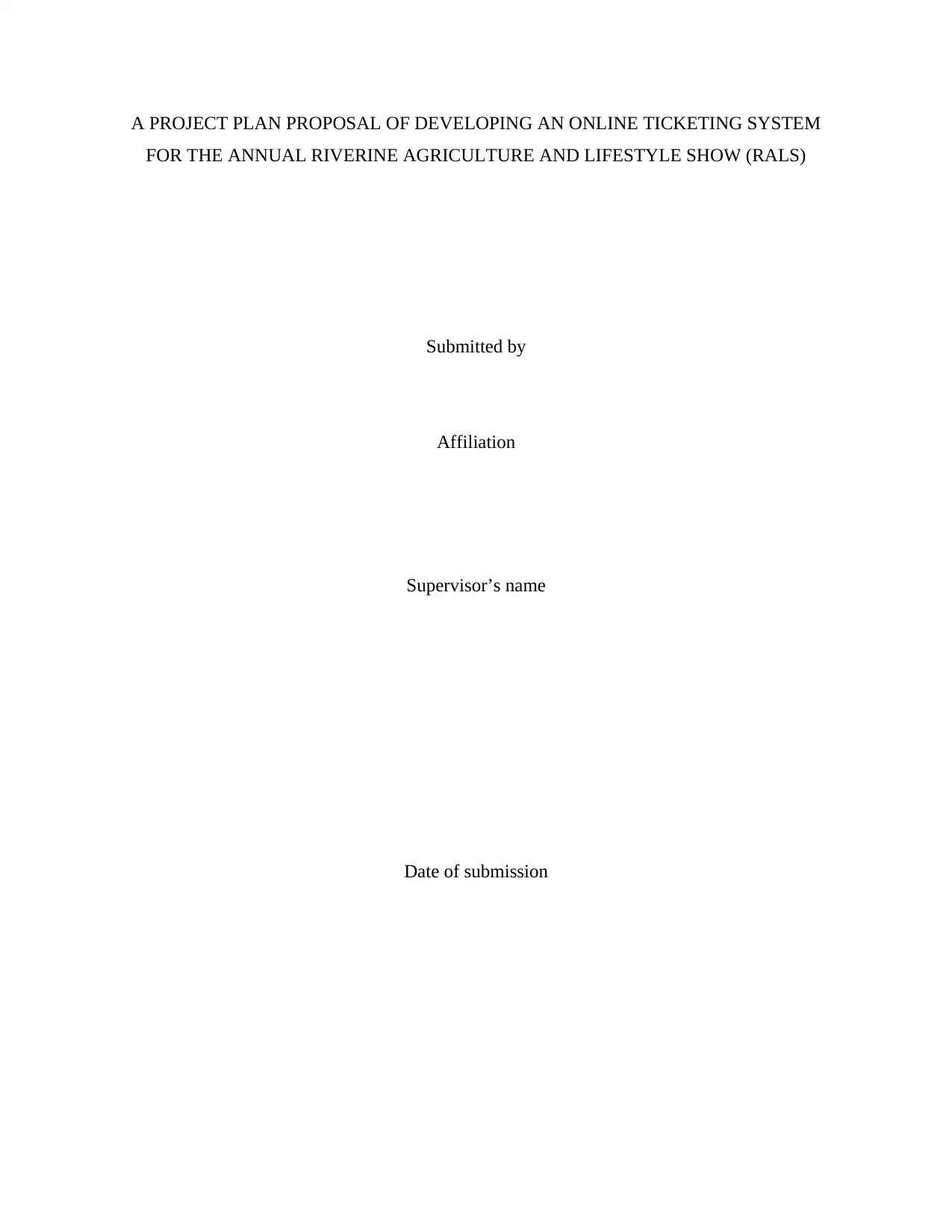
A PROJECT PLAN PROPOSAL OF DEVELOPING AN ONLINE TICKETING SYSTEM
FOR THE ANNUAL RIVERINE AGRICULTURE AND LIFESTYLE SHOW (RALS)
Submitted by
Affiliation
Supervisor’s name
Date of submission
FOR THE ANNUAL RIVERINE AGRICULTURE AND LIFESTYLE SHOW (RALS)
Submitted by
Affiliation
Supervisor’s name
Date of submission
Paraphrase This Document
Need a fresh take? Get an instant paraphrase of this document with our AI Paraphraser
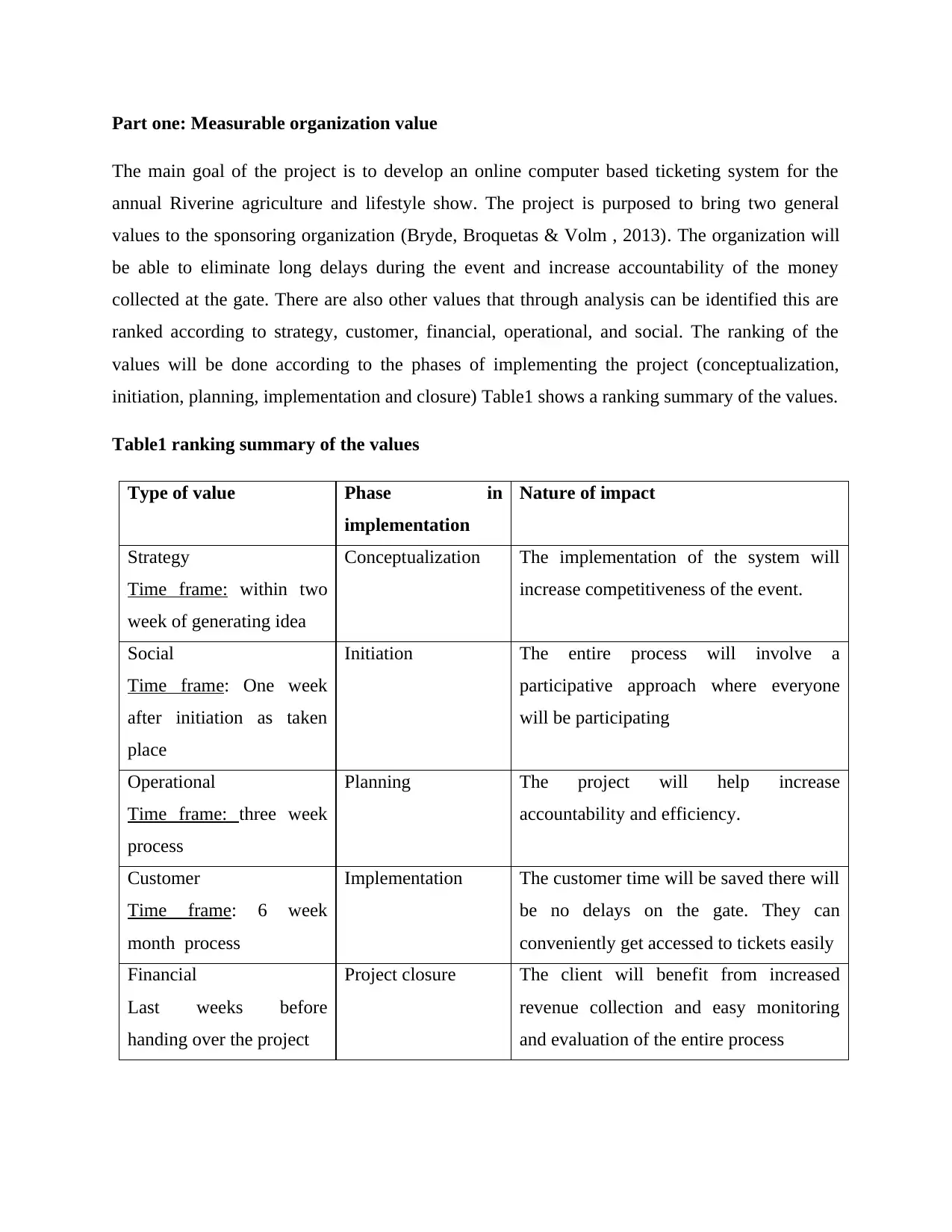
Part one: Measurable organization value
The main goal of the project is to develop an online computer based ticketing system for the
annual Riverine agriculture and lifestyle show. The project is purposed to bring two general
values to the sponsoring organization (Bryde, Broquetas & Volm , 2013). The organization will
be able to eliminate long delays during the event and increase accountability of the money
collected at the gate. There are also other values that through analysis can be identified this are
ranked according to strategy, customer, financial, operational, and social. The ranking of the
values will be done according to the phases of implementing the project (conceptualization,
initiation, planning, implementation and closure) Table1 shows a ranking summary of the values.
Table1 ranking summary of the values
Type of value Phase in
implementation
Nature of impact
Strategy
Time frame: within two
week of generating idea
Conceptualization The implementation of the system will
increase competitiveness of the event.
Social
Time frame: One week
after initiation as taken
place
Initiation The entire process will involve a
participative approach where everyone
will be participating
Operational
Time frame: three week
process
Planning The project will help increase
accountability and efficiency.
Customer
Time frame: 6 week
month process
Implementation The customer time will be saved there will
be no delays on the gate. They can
conveniently get accessed to tickets easily
Financial
Last weeks before
handing over the project
Project closure The client will benefit from increased
revenue collection and easy monitoring
and evaluation of the entire process
The main goal of the project is to develop an online computer based ticketing system for the
annual Riverine agriculture and lifestyle show. The project is purposed to bring two general
values to the sponsoring organization (Bryde, Broquetas & Volm , 2013). The organization will
be able to eliminate long delays during the event and increase accountability of the money
collected at the gate. There are also other values that through analysis can be identified this are
ranked according to strategy, customer, financial, operational, and social. The ranking of the
values will be done according to the phases of implementing the project (conceptualization,
initiation, planning, implementation and closure) Table1 shows a ranking summary of the values.
Table1 ranking summary of the values
Type of value Phase in
implementation
Nature of impact
Strategy
Time frame: within two
week of generating idea
Conceptualization The implementation of the system will
increase competitiveness of the event.
Social
Time frame: One week
after initiation as taken
place
Initiation The entire process will involve a
participative approach where everyone
will be participating
Operational
Time frame: three week
process
Planning The project will help increase
accountability and efficiency.
Customer
Time frame: 6 week
month process
Implementation The customer time will be saved there will
be no delays on the gate. They can
conveniently get accessed to tickets easily
Financial
Last weeks before
handing over the project
Project closure The client will benefit from increased
revenue collection and easy monitoring
and evaluation of the entire process
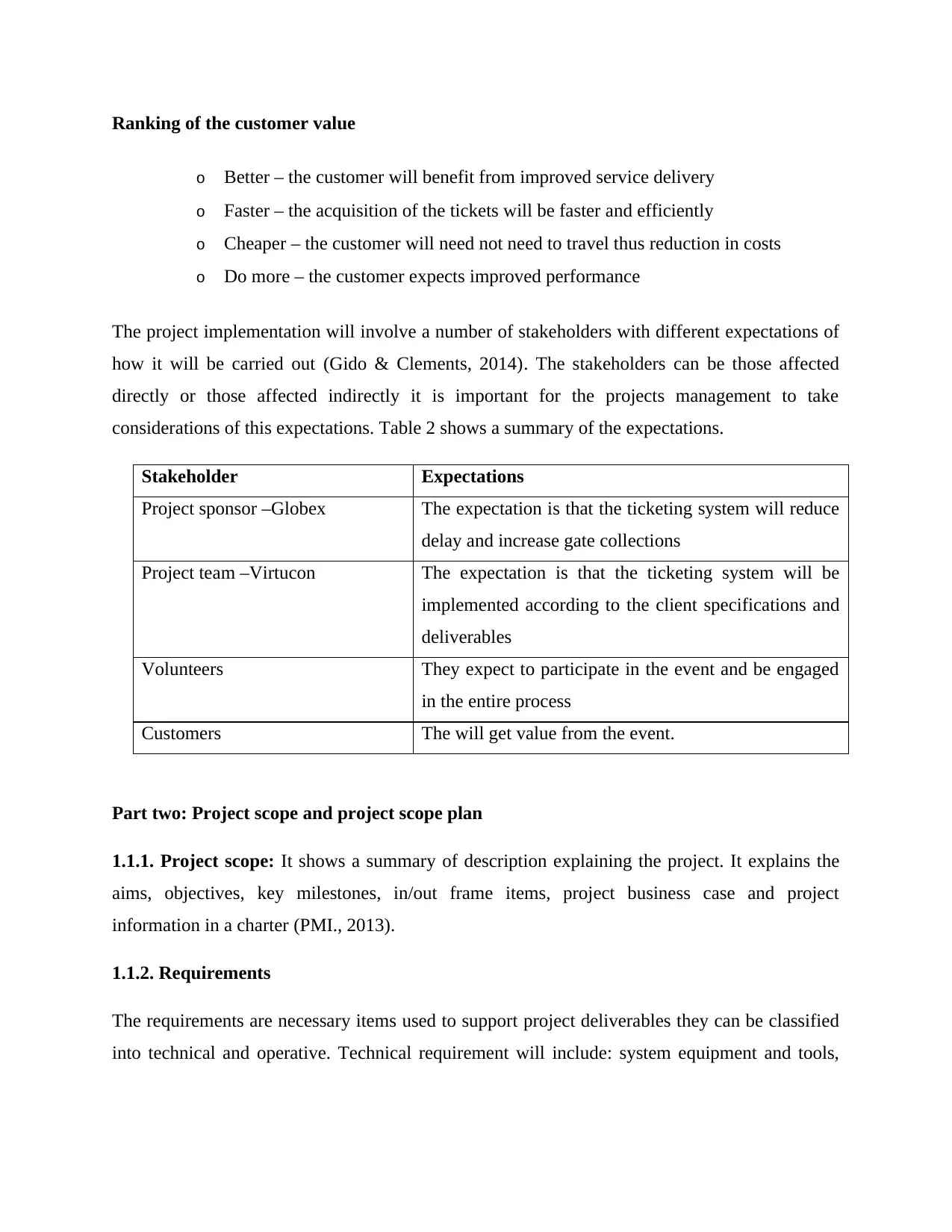
Ranking of the customer value
o Better – the customer will benefit from improved service delivery
o Faster – the acquisition of the tickets will be faster and efficiently
o Cheaper – the customer will need not need to travel thus reduction in costs
o Do more – the customer expects improved performance
The project implementation will involve a number of stakeholders with different expectations of
how it will be carried out (Gido & Clements, 2014). The stakeholders can be those affected
directly or those affected indirectly it is important for the projects management to take
considerations of this expectations. Table 2 shows a summary of the expectations.
Stakeholder Expectations
Project sponsor –Globex The expectation is that the ticketing system will reduce
delay and increase gate collections
Project team –Virtucon The expectation is that the ticketing system will be
implemented according to the client specifications and
deliverables
Volunteers They expect to participate in the event and be engaged
in the entire process
Customers The will get value from the event.
Part two: Project scope and project scope plan
1.1.1. Project scope: It shows a summary of description explaining the project. It explains the
aims, objectives, key milestones, in/out frame items, project business case and project
information in a charter (PMI., 2013).
1.1.2. Requirements
The requirements are necessary items used to support project deliverables they can be classified
into technical and operative. Technical requirement will include: system equipment and tools,
o Better – the customer will benefit from improved service delivery
o Faster – the acquisition of the tickets will be faster and efficiently
o Cheaper – the customer will need not need to travel thus reduction in costs
o Do more – the customer expects improved performance
The project implementation will involve a number of stakeholders with different expectations of
how it will be carried out (Gido & Clements, 2014). The stakeholders can be those affected
directly or those affected indirectly it is important for the projects management to take
considerations of this expectations. Table 2 shows a summary of the expectations.
Stakeholder Expectations
Project sponsor –Globex The expectation is that the ticketing system will reduce
delay and increase gate collections
Project team –Virtucon The expectation is that the ticketing system will be
implemented according to the client specifications and
deliverables
Volunteers They expect to participate in the event and be engaged
in the entire process
Customers The will get value from the event.
Part two: Project scope and project scope plan
1.1.1. Project scope: It shows a summary of description explaining the project. It explains the
aims, objectives, key milestones, in/out frame items, project business case and project
information in a charter (PMI., 2013).
1.1.2. Requirements
The requirements are necessary items used to support project deliverables they can be classified
into technical and operative. Technical requirement will include: system equipment and tools,
⊘ This is a preview!⊘
Do you want full access?
Subscribe today to unlock all pages.

Trusted by 1+ million students worldwide
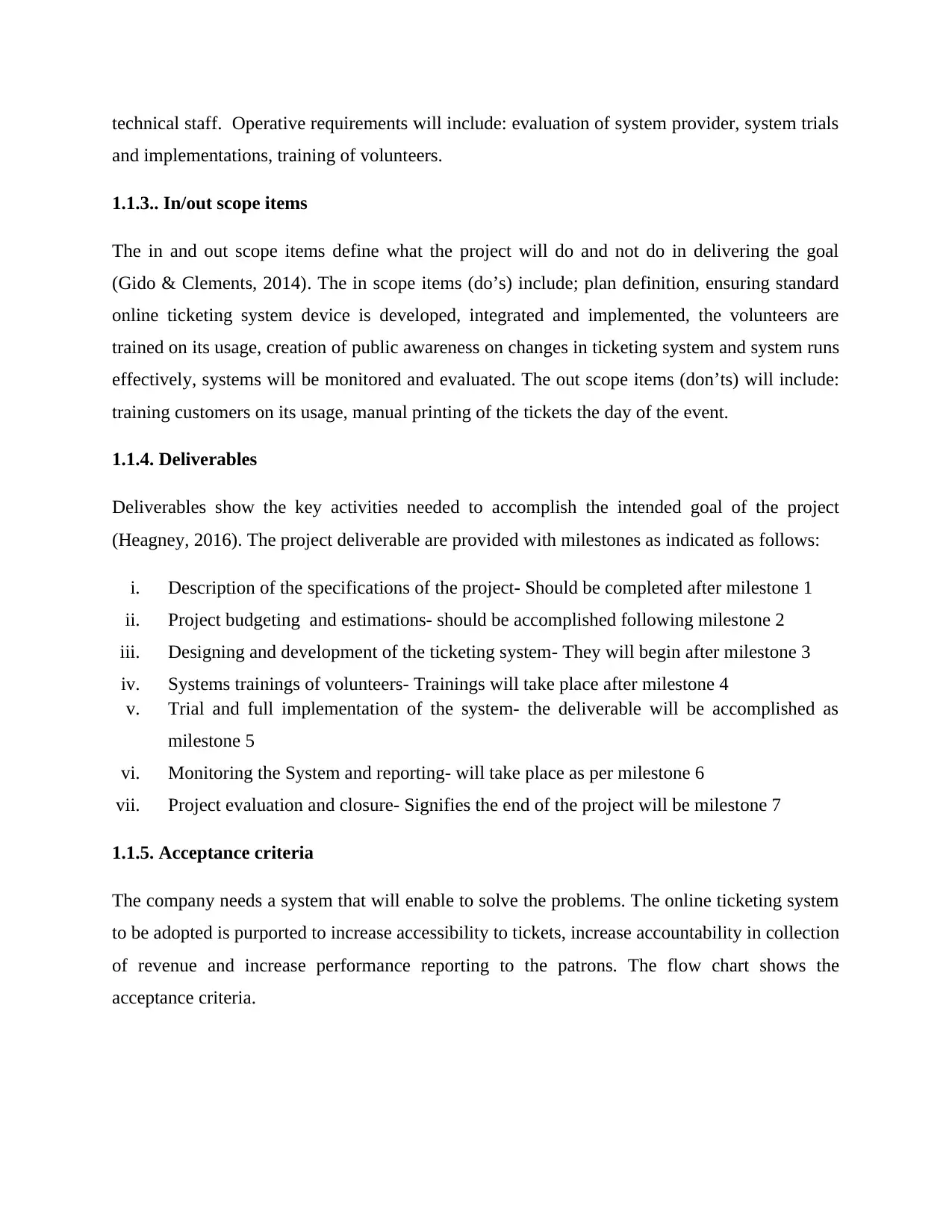
technical staff. Operative requirements will include: evaluation of system provider, system trials
and implementations, training of volunteers.
1.1.3.. In/out scope items
The in and out scope items define what the project will do and not do in delivering the goal
(Gido & Clements, 2014). The in scope items (do’s) include; plan definition, ensuring standard
online ticketing system device is developed, integrated and implemented, the volunteers are
trained on its usage, creation of public awareness on changes in ticketing system and system runs
effectively, systems will be monitored and evaluated. The out scope items (don’ts) will include:
training customers on its usage, manual printing of the tickets the day of the event.
1.1.4. Deliverables
Deliverables show the key activities needed to accomplish the intended goal of the project
(Heagney, 2016). The project deliverable are provided with milestones as indicated as follows:
i. Description of the specifications of the project- Should be completed after milestone 1
ii. Project budgeting and estimations- should be accomplished following milestone 2
iii. Designing and development of the ticketing system- They will begin after milestone 3
iv. Systems trainings of volunteers- Trainings will take place after milestone 4
v. Trial and full implementation of the system- the deliverable will be accomplished as
milestone 5
vi. Monitoring the System and reporting- will take place as per milestone 6
vii. Project evaluation and closure- Signifies the end of the project will be milestone 7
1.1.5. Acceptance criteria
The company needs a system that will enable to solve the problems. The online ticketing system
to be adopted is purported to increase accessibility to tickets, increase accountability in collection
of revenue and increase performance reporting to the patrons. The flow chart shows the
acceptance criteria.
and implementations, training of volunteers.
1.1.3.. In/out scope items
The in and out scope items define what the project will do and not do in delivering the goal
(Gido & Clements, 2014). The in scope items (do’s) include; plan definition, ensuring standard
online ticketing system device is developed, integrated and implemented, the volunteers are
trained on its usage, creation of public awareness on changes in ticketing system and system runs
effectively, systems will be monitored and evaluated. The out scope items (don’ts) will include:
training customers on its usage, manual printing of the tickets the day of the event.
1.1.4. Deliverables
Deliverables show the key activities needed to accomplish the intended goal of the project
(Heagney, 2016). The project deliverable are provided with milestones as indicated as follows:
i. Description of the specifications of the project- Should be completed after milestone 1
ii. Project budgeting and estimations- should be accomplished following milestone 2
iii. Designing and development of the ticketing system- They will begin after milestone 3
iv. Systems trainings of volunteers- Trainings will take place after milestone 4
v. Trial and full implementation of the system- the deliverable will be accomplished as
milestone 5
vi. Monitoring the System and reporting- will take place as per milestone 6
vii. Project evaluation and closure- Signifies the end of the project will be milestone 7
1.1.5. Acceptance criteria
The company needs a system that will enable to solve the problems. The online ticketing system
to be adopted is purported to increase accessibility to tickets, increase accountability in collection
of revenue and increase performance reporting to the patrons. The flow chart shows the
acceptance criteria.
Paraphrase This Document
Need a fresh take? Get an instant paraphrase of this document with our AI Paraphraser
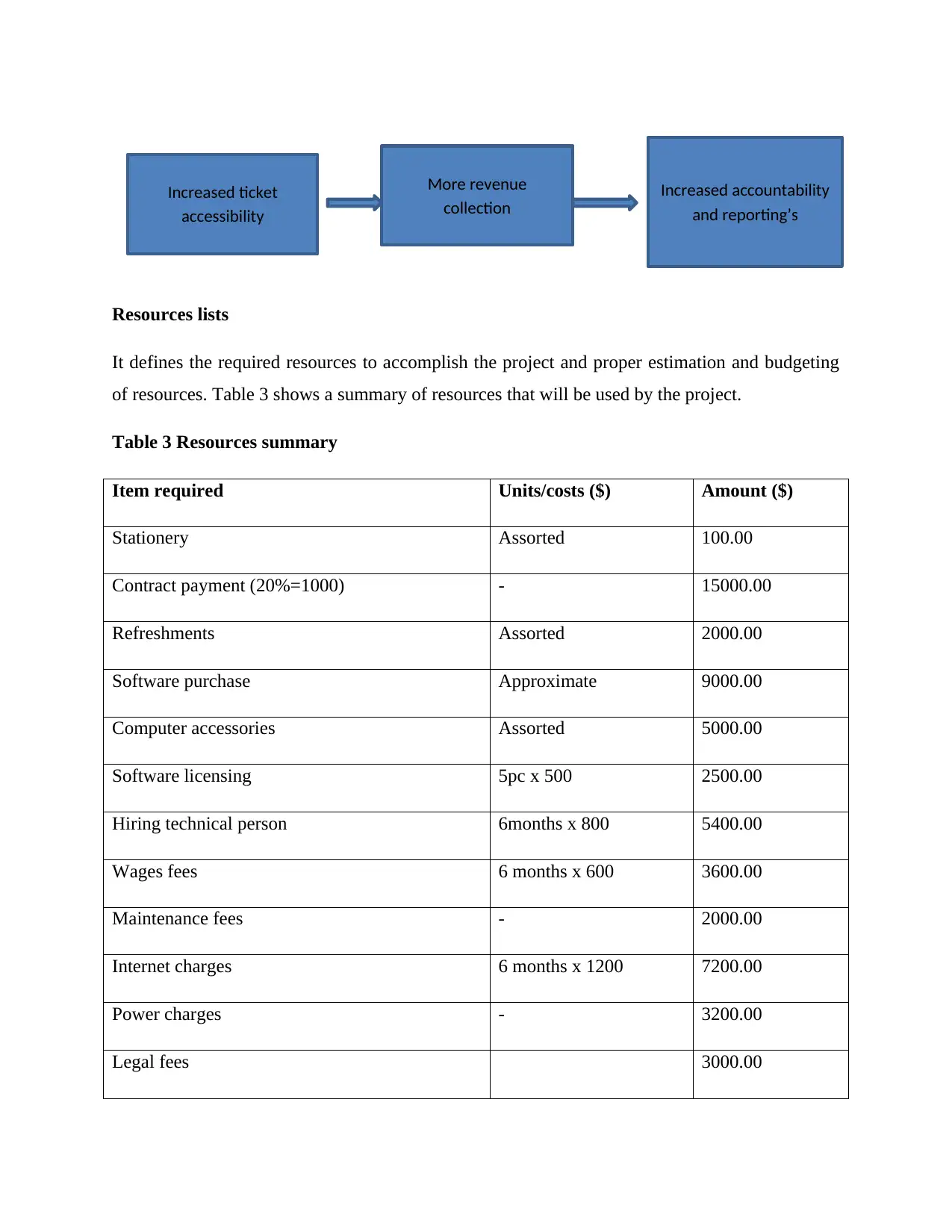
Resources lists
It defines the required resources to accomplish the project and proper estimation and budgeting
of resources. Table 3 shows a summary of resources that will be used by the project.
Table 3 Resources summary
Item required Units/costs ($) Amount ($)
Stationery Assorted 100.00
Contract payment (20%=1000) - 15000.00
Refreshments Assorted 2000.00
Software purchase Approximate 9000.00
Computer accessories Assorted 5000.00
Software licensing 5pc x 500 2500.00
Hiring technical person 6months x 800 5400.00
Wages fees 6 months x 600 3600.00
Maintenance fees - 2000.00
Internet charges 6 months x 1200 7200.00
Power charges - 3200.00
Legal fees 3000.00
Increased accountability
and reporting’s
More revenue
collection
Increased ticket
accessibility
It defines the required resources to accomplish the project and proper estimation and budgeting
of resources. Table 3 shows a summary of resources that will be used by the project.
Table 3 Resources summary
Item required Units/costs ($) Amount ($)
Stationery Assorted 100.00
Contract payment (20%=1000) - 15000.00
Refreshments Assorted 2000.00
Software purchase Approximate 9000.00
Computer accessories Assorted 5000.00
Software licensing 5pc x 500 2500.00
Hiring technical person 6months x 800 5400.00
Wages fees 6 months x 600 3600.00
Maintenance fees - 2000.00
Internet charges 6 months x 1200 7200.00
Power charges - 3200.00
Legal fees 3000.00
Increased accountability
and reporting’s
More revenue
collection
Increased ticket
accessibility

TOTAL 60500.00
⊘ This is a preview!⊘
Do you want full access?
Subscribe today to unlock all pages.

Trusted by 1+ million students worldwide
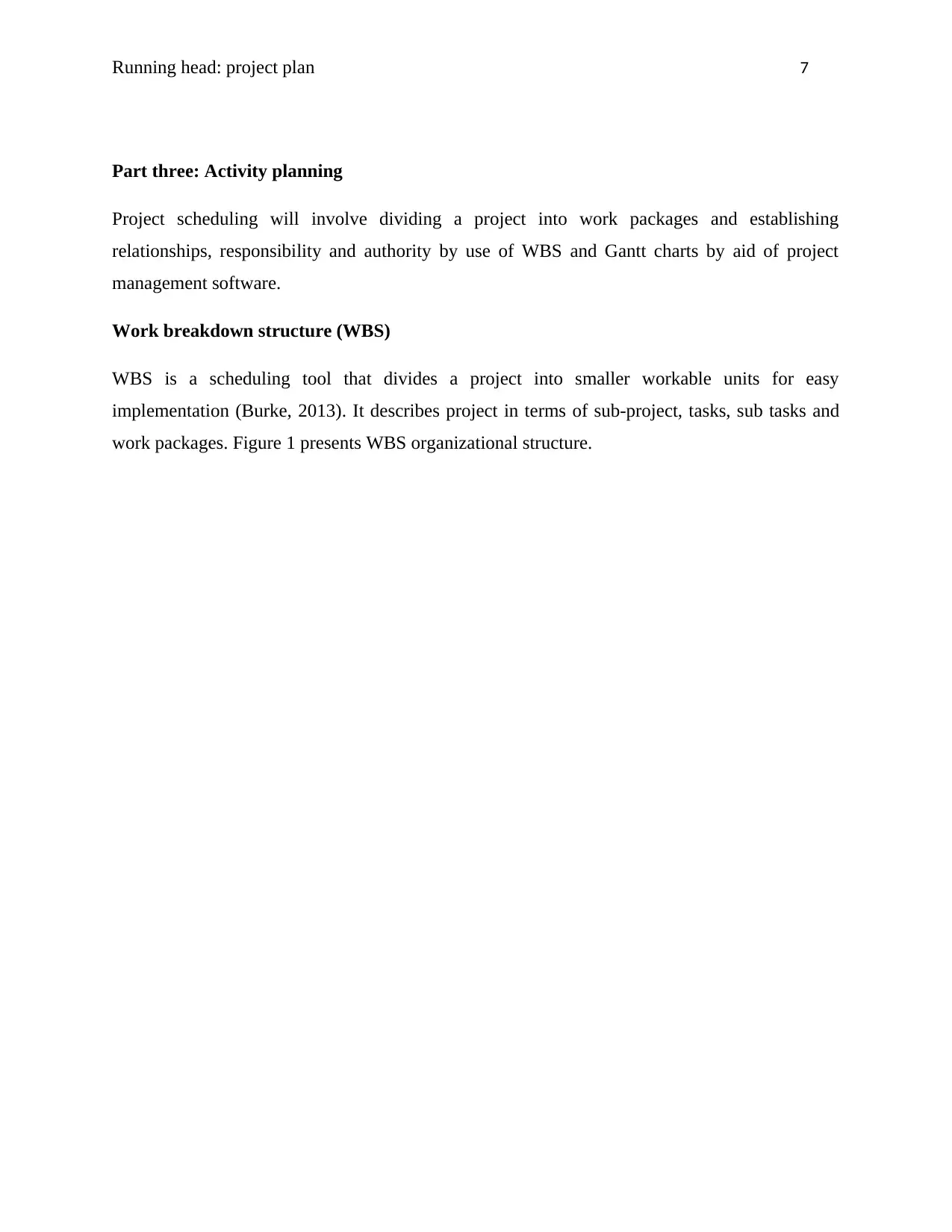
Running head: project plan 7
Part three: Activity planning
Project scheduling will involve dividing a project into work packages and establishing
relationships, responsibility and authority by use of WBS and Gantt charts by aid of project
management software.
Work breakdown structure (WBS)
WBS is a scheduling tool that divides a project into smaller workable units for easy
implementation (Burke, 2013). It describes project in terms of sub-project, tasks, sub tasks and
work packages. Figure 1 presents WBS organizational structure.
Part three: Activity planning
Project scheduling will involve dividing a project into work packages and establishing
relationships, responsibility and authority by use of WBS and Gantt charts by aid of project
management software.
Work breakdown structure (WBS)
WBS is a scheduling tool that divides a project into smaller workable units for easy
implementation (Burke, 2013). It describes project in terms of sub-project, tasks, sub tasks and
work packages. Figure 1 presents WBS organizational structure.
Paraphrase This Document
Need a fresh take? Get an instant paraphrase of this document with our AI Paraphraser
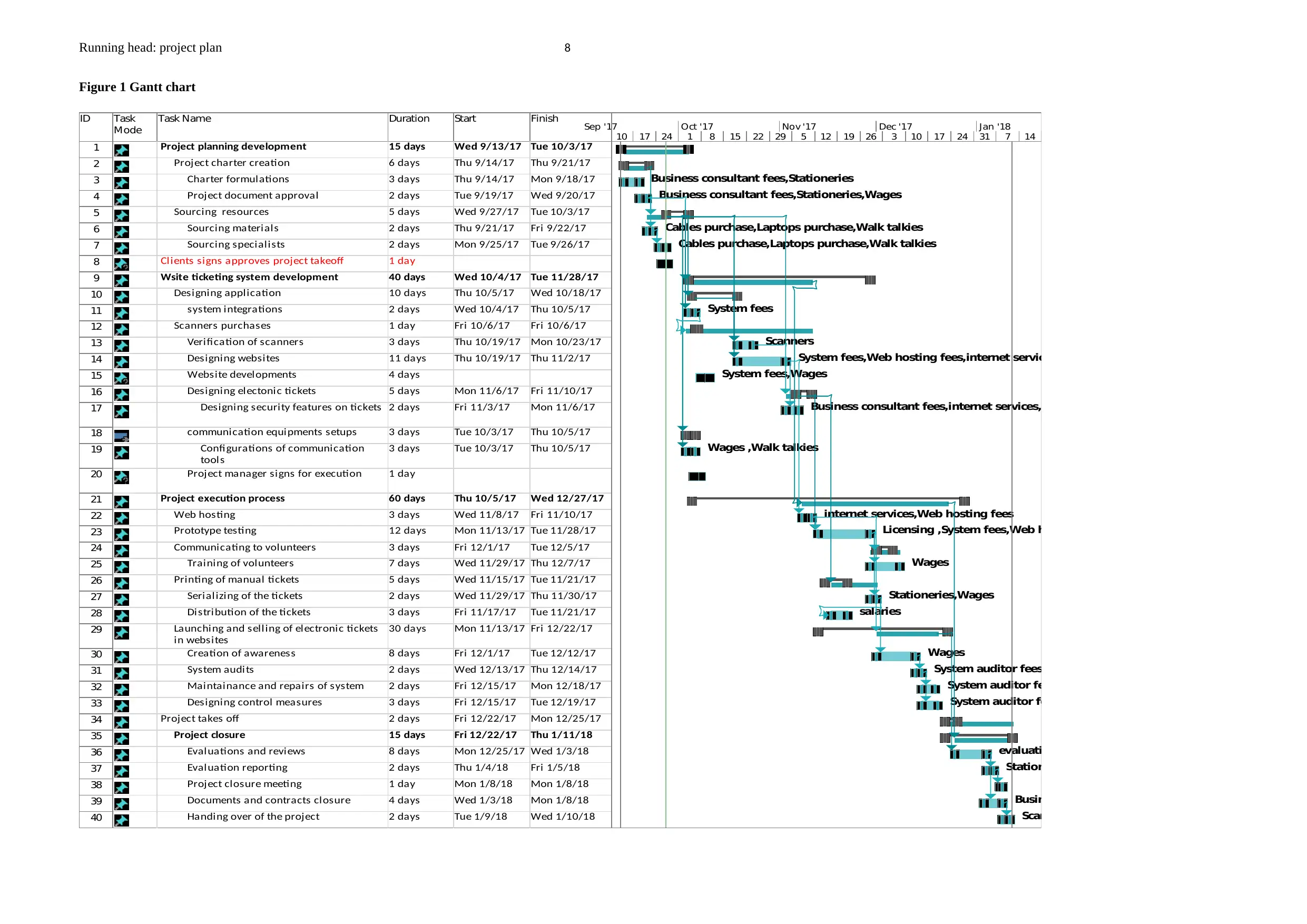
Running head: project plan 8
Figure 1 Gantt chart
ID Task
Mode
Task Name Duration Start Finish
1 Project planning development 15 days Wed 9/13/17 Tue 10/3/17
2 Project charter creation 6 days Thu 9/14/17 Thu 9/21/17
3 Charter formulations 3 days Thu 9/14/17 Mon 9/18/17
4 Project document approval 2 days Tue 9/19/17 Wed 9/20/17
5 Sourcing resources 5 days Wed 9/27/17 Tue 10/3/17
6 Sourcing materials 2 days Thu 9/21/17 Fri 9/22/17
7 Sourcing specialists 2 days Mon 9/25/17 Tue 9/26/17
8 Clients signs approves project takeoff 1 day
9 Wsite ticketing system development 40 days Wed 10/4/17 Tue 11/28/17
10 Designing application 10 days Thu 10/5/17 Wed 10/18/17
11 system integrations 2 days Wed 10/4/17 Thu 10/5/17
12 Scanners purchases 1 day Fri 10/6/17 Fri 10/6/17
13 Verification of scanners 3 days Thu 10/19/17 Mon 10/23/17
14 Designing websites 11 days Thu 10/19/17 Thu 11/2/17
15 Website developments 4 days
16 Designing electonic tickets 5 days Mon 11/6/17 Fri 11/10/17
17 Designing security features on tickets 2 days Fri 11/3/17 Mon 11/6/17
18 communication equipments setups 3 days Tue 10/3/17 Thu 10/5/17
19 Configurations of communication
tools
3 days Tue 10/3/17 Thu 10/5/17
20 Project manager signs for execution 1 day
21 Project execution process 60 days Thu 10/5/17 Wed 12/27/17
22 Web hosting 3 days Wed 11/8/17 Fri 11/10/17
23 Prototype testing 12 days Mon 11/13/17 Tue 11/28/17
24 Communicating to volunteers 3 days Fri 12/1/17 Tue 12/5/17
25 Training of volunteers 7 days Wed 11/29/17 Thu 12/7/17
26 Printing of manual tickets 5 days Wed 11/15/17 Tue 11/21/17
27 Serializing of the tickets 2 days Wed 11/29/17 Thu 11/30/17
28 Distribution of the tickets 3 days Fri 11/17/17 Tue 11/21/17
29 Launching and selling of electronic tickets
in websites
30 days Mon 11/13/17 Fri 12/22/17
30 Creation of awareness 8 days Fri 12/1/17 Tue 12/12/17
31 System audits 2 days Wed 12/13/17 Thu 12/14/17
32 Maintainance and repairs of system 2 days Fri 12/15/17 Mon 12/18/17
33 Designing control measures 3 days Fri 12/15/17 Tue 12/19/17
34 Project takes off 2 days Fri 12/22/17 Mon 12/25/17
35 Project closure 15 days Fri 12/22/17 Thu 1/11/18
36 Evaluations and reviews 8 days Mon 12/25/17 Wed 1/3/18
37 Evaluation reporting 2 days Thu 1/4/18 Fri 1/5/18
38 Project closure meeting 1 day Mon 1/8/18 Mon 1/8/18
39 Documents and contracts closure 4 days Wed 1/3/18 Mon 1/8/18
40 Handing over of the project 2 days Tue 1/9/18 Wed 1/10/18
Business consultant fees,Stationeries
Business consultant fees,Stationeries,Wages
Cables purchase,Laptops purchase,Walk talkies
Cables purchase,Laptops purchase,Walk talkies
System fees
Scanners
System fees,Web hosting fees,internet services
System fees,Wages
Business consultant fees,internet services,System fees,Web hosting fees
Wages ,Walk talkies
internet services,Web hosting fees
Licensing ,System fees,Web hosting fees
Wages
Stationeries,Wages
salaries
Wages
System auditor fees,System fees
System auditor fees,System fees
System auditor fees,System fees
evaluation expert fees
Stationeries
Business consultant fees
Scanners[10%],evaluation expert fees,Business consu
10 17 24 1 8 15 22 29 5 12 19 26 3 10 17 24 31 7 14
Sep '17 Oct '17 Nov '17 Dec '17 Jan '18
Figure 1 Gantt chart
ID Task
Mode
Task Name Duration Start Finish
1 Project planning development 15 days Wed 9/13/17 Tue 10/3/17
2 Project charter creation 6 days Thu 9/14/17 Thu 9/21/17
3 Charter formulations 3 days Thu 9/14/17 Mon 9/18/17
4 Project document approval 2 days Tue 9/19/17 Wed 9/20/17
5 Sourcing resources 5 days Wed 9/27/17 Tue 10/3/17
6 Sourcing materials 2 days Thu 9/21/17 Fri 9/22/17
7 Sourcing specialists 2 days Mon 9/25/17 Tue 9/26/17
8 Clients signs approves project takeoff 1 day
9 Wsite ticketing system development 40 days Wed 10/4/17 Tue 11/28/17
10 Designing application 10 days Thu 10/5/17 Wed 10/18/17
11 system integrations 2 days Wed 10/4/17 Thu 10/5/17
12 Scanners purchases 1 day Fri 10/6/17 Fri 10/6/17
13 Verification of scanners 3 days Thu 10/19/17 Mon 10/23/17
14 Designing websites 11 days Thu 10/19/17 Thu 11/2/17
15 Website developments 4 days
16 Designing electonic tickets 5 days Mon 11/6/17 Fri 11/10/17
17 Designing security features on tickets 2 days Fri 11/3/17 Mon 11/6/17
18 communication equipments setups 3 days Tue 10/3/17 Thu 10/5/17
19 Configurations of communication
tools
3 days Tue 10/3/17 Thu 10/5/17
20 Project manager signs for execution 1 day
21 Project execution process 60 days Thu 10/5/17 Wed 12/27/17
22 Web hosting 3 days Wed 11/8/17 Fri 11/10/17
23 Prototype testing 12 days Mon 11/13/17 Tue 11/28/17
24 Communicating to volunteers 3 days Fri 12/1/17 Tue 12/5/17
25 Training of volunteers 7 days Wed 11/29/17 Thu 12/7/17
26 Printing of manual tickets 5 days Wed 11/15/17 Tue 11/21/17
27 Serializing of the tickets 2 days Wed 11/29/17 Thu 11/30/17
28 Distribution of the tickets 3 days Fri 11/17/17 Tue 11/21/17
29 Launching and selling of electronic tickets
in websites
30 days Mon 11/13/17 Fri 12/22/17
30 Creation of awareness 8 days Fri 12/1/17 Tue 12/12/17
31 System audits 2 days Wed 12/13/17 Thu 12/14/17
32 Maintainance and repairs of system 2 days Fri 12/15/17 Mon 12/18/17
33 Designing control measures 3 days Fri 12/15/17 Tue 12/19/17
34 Project takes off 2 days Fri 12/22/17 Mon 12/25/17
35 Project closure 15 days Fri 12/22/17 Thu 1/11/18
36 Evaluations and reviews 8 days Mon 12/25/17 Wed 1/3/18
37 Evaluation reporting 2 days Thu 1/4/18 Fri 1/5/18
38 Project closure meeting 1 day Mon 1/8/18 Mon 1/8/18
39 Documents and contracts closure 4 days Wed 1/3/18 Mon 1/8/18
40 Handing over of the project 2 days Tue 1/9/18 Wed 1/10/18
Business consultant fees,Stationeries
Business consultant fees,Stationeries,Wages
Cables purchase,Laptops purchase,Walk talkies
Cables purchase,Laptops purchase,Walk talkies
System fees
Scanners
System fees,Web hosting fees,internet services
System fees,Wages
Business consultant fees,internet services,System fees,Web hosting fees
Wages ,Walk talkies
internet services,Web hosting fees
Licensing ,System fees,Web hosting fees
Wages
Stationeries,Wages
salaries
Wages
System auditor fees,System fees
System auditor fees,System fees
System auditor fees,System fees
evaluation expert fees
Stationeries
Business consultant fees
Scanners[10%],evaluation expert fees,Business consu
10 17 24 1 8 15 22 29 5 12 19 26 3 10 17 24 31 7 14
Sep '17 Oct '17 Nov '17 Dec '17 Jan '18
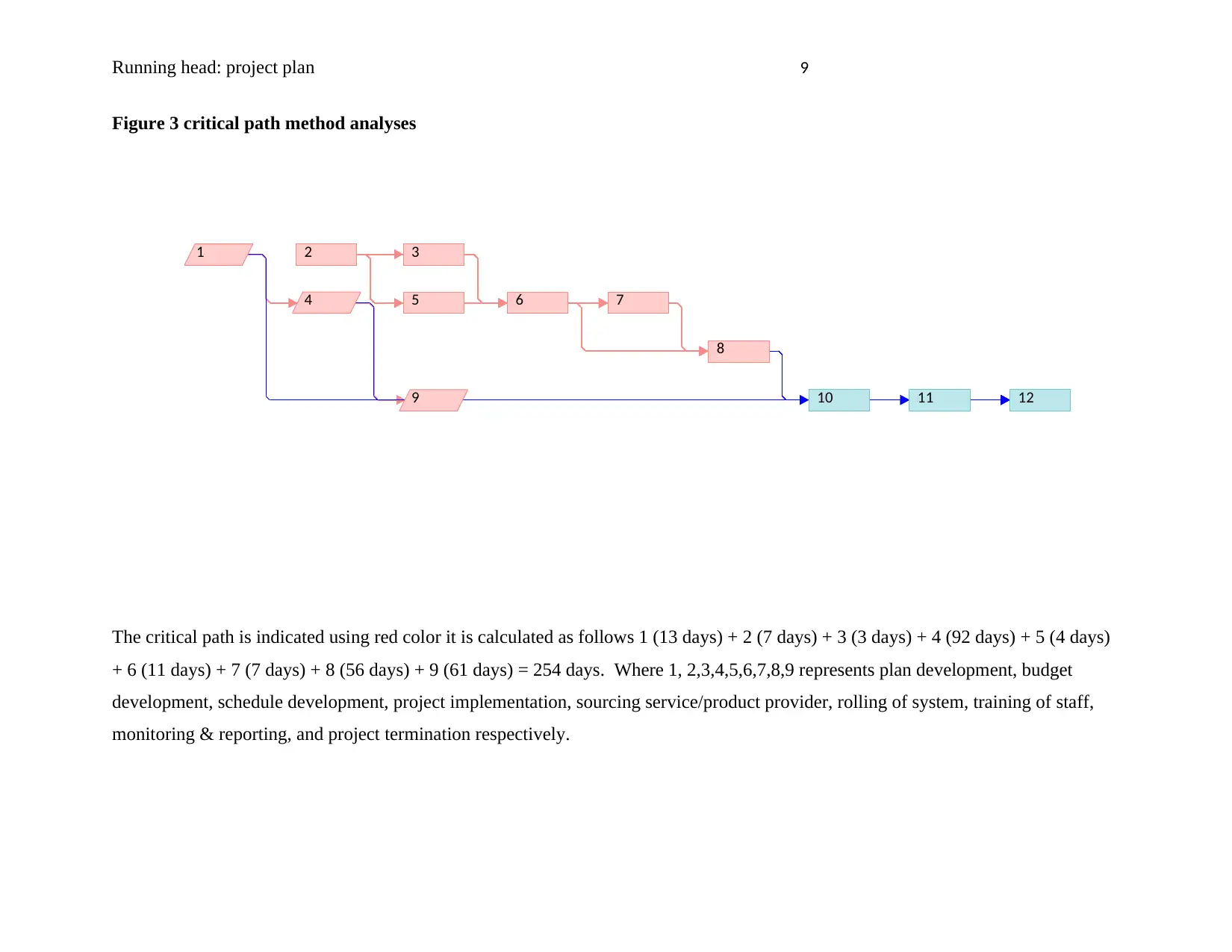
Running head: project plan 9
Figure 3 critical path method analyses
3
4 5 6 7
8
9 10 11
2
12
1
The critical path is indicated using red color it is calculated as follows 1 (13 days) + 2 (7 days) + 3 (3 days) + 4 (92 days) + 5 (4 days)
+ 6 (11 days) + 7 (7 days) + 8 (56 days) + 9 (61 days) = 254 days. Where 1, 2,3,4,5,6,7,8,9 represents plan development, budget
development, schedule development, project implementation, sourcing service/product provider, rolling of system, training of staff,
monitoring & reporting, and project termination respectively.
Figure 3 critical path method analyses
3
4 5 6 7
8
9 10 11
2
12
1
The critical path is indicated using red color it is calculated as follows 1 (13 days) + 2 (7 days) + 3 (3 days) + 4 (92 days) + 5 (4 days)
+ 6 (11 days) + 7 (7 days) + 8 (56 days) + 9 (61 days) = 254 days. Where 1, 2,3,4,5,6,7,8,9 represents plan development, budget
development, schedule development, project implementation, sourcing service/product provider, rolling of system, training of staff,
monitoring & reporting, and project termination respectively.
⊘ This is a preview!⊘
Do you want full access?
Subscribe today to unlock all pages.

Trusted by 1+ million students worldwide
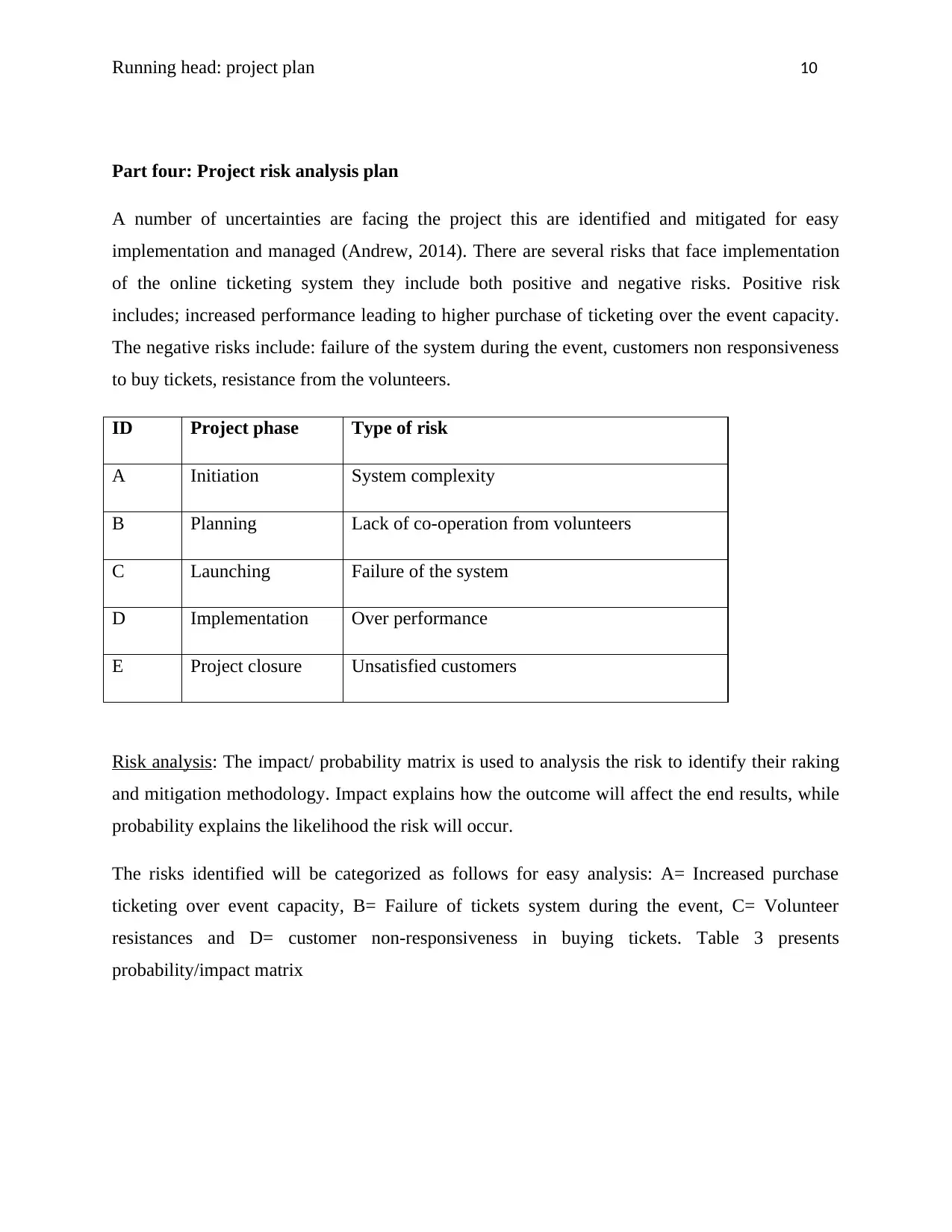
Running head: project plan 10
Part four: Project risk analysis plan
A number of uncertainties are facing the project this are identified and mitigated for easy
implementation and managed (Andrew, 2014). There are several risks that face implementation
of the online ticketing system they include both positive and negative risks. Positive risk
includes; increased performance leading to higher purchase of ticketing over the event capacity.
The negative risks include: failure of the system during the event, customers non responsiveness
to buy tickets, resistance from the volunteers.
ID Project phase Type of risk
A Initiation System complexity
B Planning Lack of co-operation from volunteers
C Launching Failure of the system
D Implementation Over performance
E Project closure Unsatisfied customers
Risk analysis: The impact/ probability matrix is used to analysis the risk to identify their raking
and mitigation methodology. Impact explains how the outcome will affect the end results, while
probability explains the likelihood the risk will occur.
The risks identified will be categorized as follows for easy analysis: A= Increased purchase
ticketing over event capacity, B= Failure of tickets system during the event, C= Volunteer
resistances and D= customer non-responsiveness in buying tickets. Table 3 presents
probability/impact matrix
Part four: Project risk analysis plan
A number of uncertainties are facing the project this are identified and mitigated for easy
implementation and managed (Andrew, 2014). There are several risks that face implementation
of the online ticketing system they include both positive and negative risks. Positive risk
includes; increased performance leading to higher purchase of ticketing over the event capacity.
The negative risks include: failure of the system during the event, customers non responsiveness
to buy tickets, resistance from the volunteers.
ID Project phase Type of risk
A Initiation System complexity
B Planning Lack of co-operation from volunteers
C Launching Failure of the system
D Implementation Over performance
E Project closure Unsatisfied customers
Risk analysis: The impact/ probability matrix is used to analysis the risk to identify their raking
and mitigation methodology. Impact explains how the outcome will affect the end results, while
probability explains the likelihood the risk will occur.
The risks identified will be categorized as follows for easy analysis: A= Increased purchase
ticketing over event capacity, B= Failure of tickets system during the event, C= Volunteer
resistances and D= customer non-responsiveness in buying tickets. Table 3 presents
probability/impact matrix
Paraphrase This Document
Need a fresh take? Get an instant paraphrase of this document with our AI Paraphraser
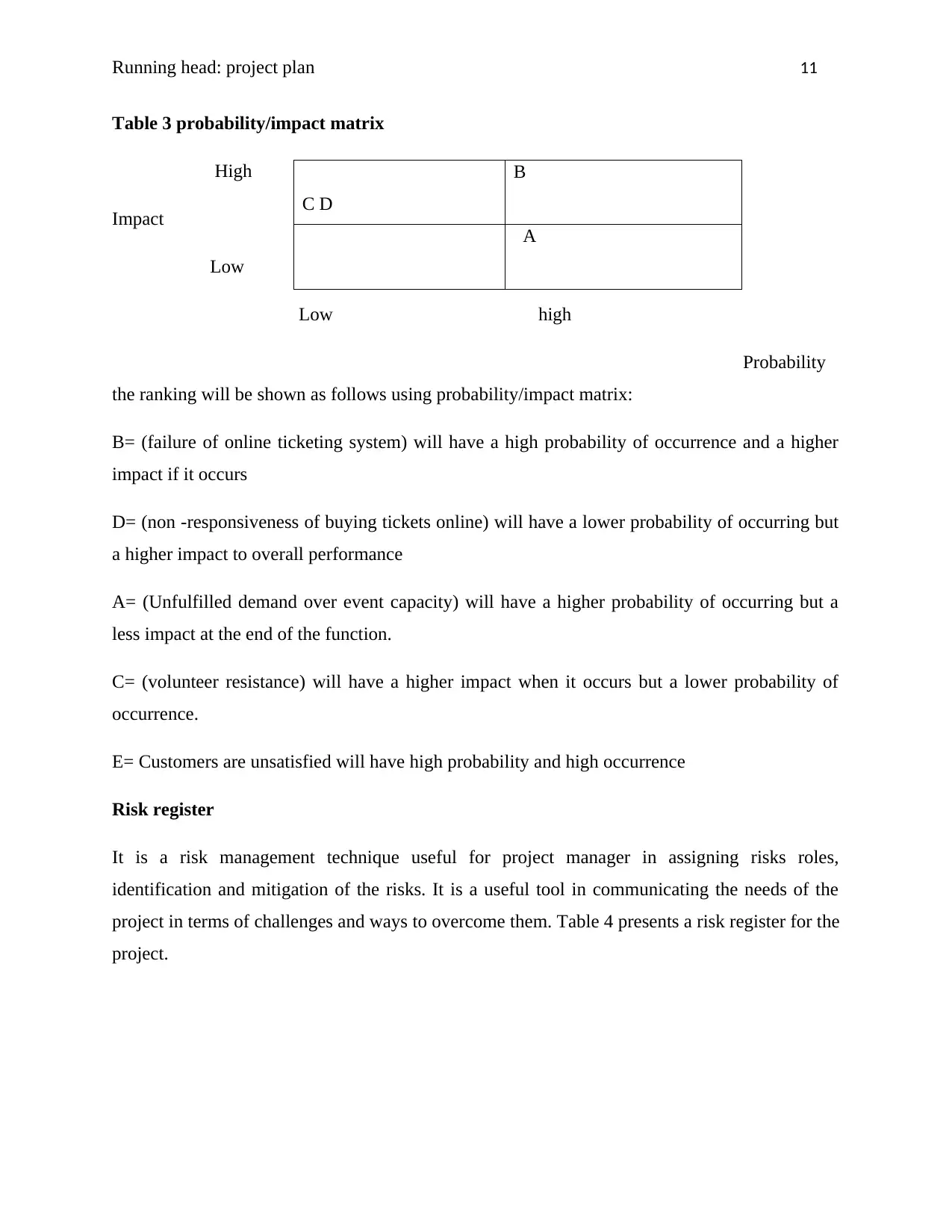
Running head: project plan 11
Table 3 probability/impact matrix
High
Impact
Low
Low high
Probability
the ranking will be shown as follows using probability/impact matrix:
B= (failure of online ticketing system) will have a high probability of occurrence and a higher
impact if it occurs
D= (non -responsiveness of buying tickets online) will have a lower probability of occurring but
a higher impact to overall performance
A= (Unfulfilled demand over event capacity) will have a higher probability of occurring but a
less impact at the end of the function.
C= (volunteer resistance) will have a higher impact when it occurs but a lower probability of
occurrence.
E= Customers are unsatisfied will have high probability and high occurrence
Risk register
It is a risk management technique useful for project manager in assigning risks roles,
identification and mitigation of the risks. It is a useful tool in communicating the needs of the
project in terms of challenges and ways to overcome them. Table 4 presents a risk register for the
project.
C D
B
A
Table 3 probability/impact matrix
High
Impact
Low
Low high
Probability
the ranking will be shown as follows using probability/impact matrix:
B= (failure of online ticketing system) will have a high probability of occurrence and a higher
impact if it occurs
D= (non -responsiveness of buying tickets online) will have a lower probability of occurring but
a higher impact to overall performance
A= (Unfulfilled demand over event capacity) will have a higher probability of occurring but a
less impact at the end of the function.
C= (volunteer resistance) will have a higher impact when it occurs but a lower probability of
occurrence.
E= Customers are unsatisfied will have high probability and high occurrence
Risk register
It is a risk management technique useful for project manager in assigning risks roles,
identification and mitigation of the risks. It is a useful tool in communicating the needs of the
project in terms of challenges and ways to overcome them. Table 4 presents a risk register for the
project.
C D
B
A
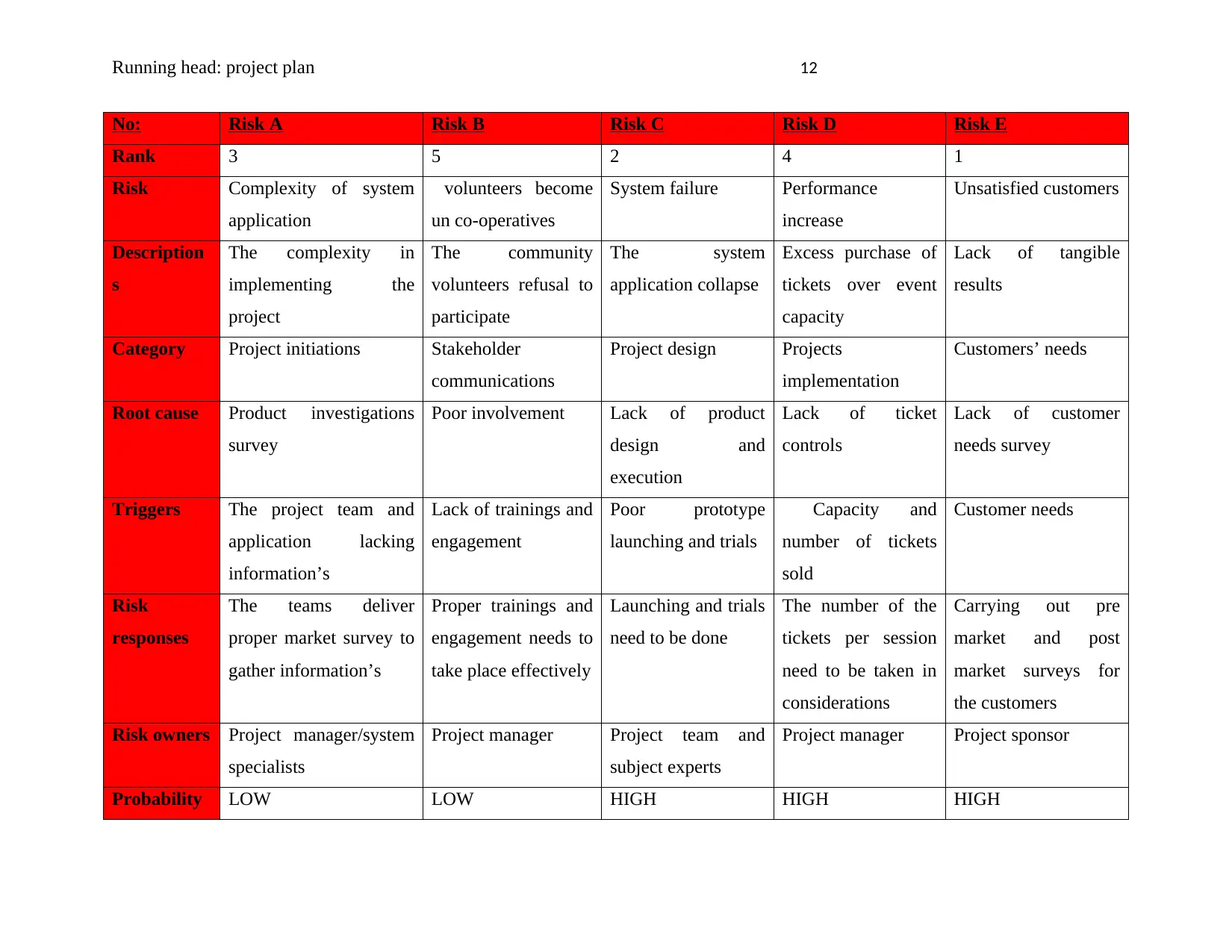
Running head: project plan 12
No: Risk A Risk B Risk C Risk D Risk E
Rank 3 5 2 4 1
Risk Complexity of system
application
volunteers become
un co-operatives
System failure Performance
increase
Unsatisfied customers
Description
s
The complexity in
implementing the
project
The community
volunteers refusal to
participate
The system
application collapse
Excess purchase of
tickets over event
capacity
Lack of tangible
results
Category Project initiations Stakeholder
communications
Project design Projects
implementation
Customers’ needs
Root cause Product investigations
survey
Poor involvement Lack of product
design and
execution
Lack of ticket
controls
Lack of customer
needs survey
Triggers The project team and
application lacking
information’s
Lack of trainings and
engagement
Poor prototype
launching and trials
Capacity and
number of tickets
sold
Customer needs
Risk
responses
The teams deliver
proper market survey to
gather information’s
Proper trainings and
engagement needs to
take place effectively
Launching and trials
need to be done
The number of the
tickets per session
need to be taken in
considerations
Carrying out pre
market and post
market surveys for
the customers
Risk owners Project manager/system
specialists
Project manager Project team and
subject experts
Project manager Project sponsor
Probability LOW LOW HIGH HIGH HIGH
No: Risk A Risk B Risk C Risk D Risk E
Rank 3 5 2 4 1
Risk Complexity of system
application
volunteers become
un co-operatives
System failure Performance
increase
Unsatisfied customers
Description
s
The complexity in
implementing the
project
The community
volunteers refusal to
participate
The system
application collapse
Excess purchase of
tickets over event
capacity
Lack of tangible
results
Category Project initiations Stakeholder
communications
Project design Projects
implementation
Customers’ needs
Root cause Product investigations
survey
Poor involvement Lack of product
design and
execution
Lack of ticket
controls
Lack of customer
needs survey
Triggers The project team and
application lacking
information’s
Lack of trainings and
engagement
Poor prototype
launching and trials
Capacity and
number of tickets
sold
Customer needs
Risk
responses
The teams deliver
proper market survey to
gather information’s
Proper trainings and
engagement needs to
take place effectively
Launching and trials
need to be done
The number of the
tickets per session
need to be taken in
considerations
Carrying out pre
market and post
market surveys for
the customers
Risk owners Project manager/system
specialists
Project manager Project team and
subject experts
Project manager Project sponsor
Probability LOW LOW HIGH HIGH HIGH
⊘ This is a preview!⊘
Do you want full access?
Subscribe today to unlock all pages.

Trusted by 1+ million students worldwide
1 out of 20
Related Documents
Your All-in-One AI-Powered Toolkit for Academic Success.
+13062052269
info@desklib.com
Available 24*7 on WhatsApp / Email
![[object Object]](/_next/static/media/star-bottom.7253800d.svg)
Unlock your academic potential
Copyright © 2020–2025 A2Z Services. All Rights Reserved. Developed and managed by ZUCOL.





